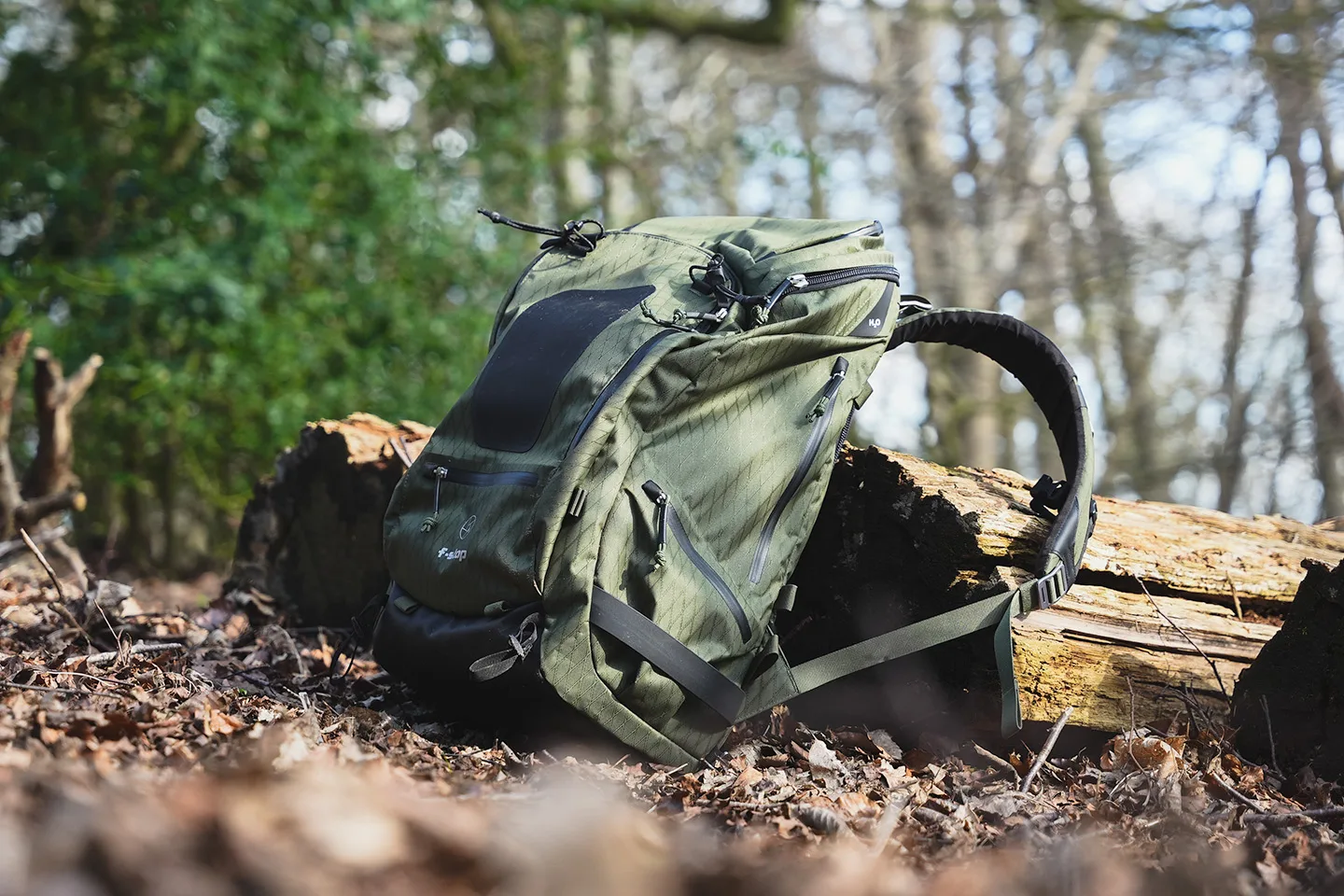
We’ve been travelling and taking photos for the better part of the last eight years, and there’s one piece of gear that’s stuck with us for all those years—our F-Stop Gear Tilopa camera bag. We’ve flirted with other camera bags over the years, but nothing has come close to being as reliable, comfortable, and useful as the big blue bag. So when we heard a new version of the bag was released, F-Stop Gear Tilopa Duradiamond, we knew we wanted to pick one up and see what changes were made.

This review is not sponsored, and we bought all our F-Stop Gear products with our own money. We know how difficult it can be to find a camera bag that perfectly fits all your needs, so we wanted to write this review in the hopes it will be helpful for someone when looking for their next camera bag. If you decide to pick up a Tilopa or one of F-Stop Gear’s other bags, you can use our affiliate link which helps support the blog and brings you more photography and travel content (at no extra cost to you).
Size and Weight

Both the old and new Tilopa Duradiamond have the same capacity of 50 litres. We wanted to mention the bag’s size straight away as this could be an instant deal-breaker for some; it doesn’t matter how good the bag is if it’s too small or too big for your needs. For reference, 50 litres is five more than Peak Design’s Travel Backpack and 20 litres more than their popular Everyday Backpack.

Inside our 50-litre Tilopa Duradiamond, we normally carry the following camera gear:
- Sony A7IV
- Sigma 16-28 f2.8
- Sigma 24-70 f2.8
- Sony 70-200 f4
- DJI Mavic Pro
- DJI RS3 Mini Gimbal
- Rode Video Mic Go
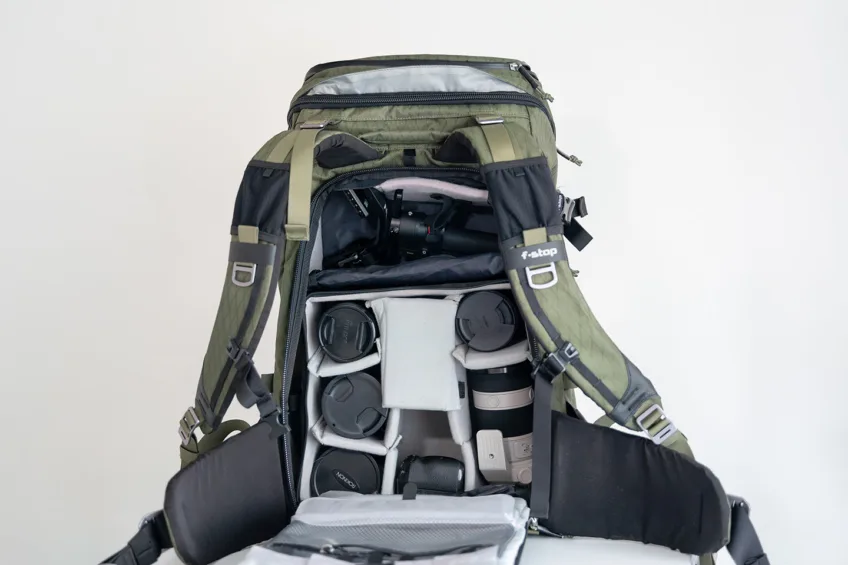
The camera gear takes up around half of the bag, which leaves 20 odd litres of space for Eric’s travel necessities. This leaves plenty of space for a few days’ worth of clothes, a 13” laptop, several hard drives, toiletries, and additional chargers, plugs, and adapters needed to work on the go.
We’ve tried bigger bags in the past, but just ended up overpacking or never using the additional space. 50 litres has been the sweet spot for anything longer than a weekend trip. If we require more gear then we move Eric’s travel items over to a separate suitcase and use the Tilopa to carry camera gear-only.
We weighed the new Tilopa Duradiamond empty (no internal camera unit) at 2.1kg which is heavier than the original Tilopa (1.9kg). The increase in weight does feel disappointing but thankfully was unnoticeable when worn. After using the bag on a few trips we feel the increase in weight is worth it for the changes made.
Our weigh-in for the Duradiamond came in heavier than the official listed item weight which is touted as 1.9kg. This could be a difference in measuring scales. Below is a comparison of similar-sized bags on the market and their manufacturer-listed weight (sadly, we don’t own the other bags and can’t verify if the actual weight of the other bags is accurate to the listed).
- Peak Design 45 litres Travel Backpack – 2.05kg
- Shimoda Action X50 v2 Backpack – 2.1kg
- Old F-Stop Gear Tilopa – 1.9kg
Bag Exterior

The most significant change to the bag’s exterior is the move away from 420D ripstop nylon (with TPU laminate) to their proprietary Duradiamond material, which they claim is stronger, more weather-resistant, and lighter at the same time. Visually, the material has a more pronounced criss-cross pattern over the muted square pattern of the old Tilopa.


To touch, the new Duradiamond material feels sturdier and more synthetic than the previous. The old Tilopa was an absolute beast in its durability, surviving eight years of battering with only slight discolouration from dirt and dust to show its age. The bar is already incredibly high, so if the Duradiamond lives up to its claim of being more durable, that would be an incredible feat. We’ll have to wait and see if it truly stands the test of time.

One point we can immediately confirm is that the Duradiamond material is more weather-resistant. We’ve tested this at home spraying the bag directly using a garden hose.
We did a little competition between the old and new Tilopa. At first, the old Tilopa does well but the nylon material saturates with water. Eventually, the moisture seeps through and you can visibly see the build-up of water inside (especially in the top compartment). The new Duradiamond version was completely bone dry inside all compartments.
The TPU laminate on our eight-year-old bag could have worn and rubbed off over time, so we did the same test with an F-Stop Gear Ajna (the smaller brother of the Tilopa) we purchased a little over two years ago. This bag also uses the same 420D ripstop nylon as the old Tilopa but it’s hardly been used in comparison so the TPU laminate should be fairly intact. We got slightly better results than the old Tilopa but still not bone-dry like the new Duradiamond Tilopa. Of course, if you threw on a rain cover, all three bags would be perfectly safe and dry, but it’s great knowing your gear will be safer from water if you find yourself without a rain cover or can’t be bothered to put one on.

Also helping the weather resistance are the new woven-in welded zippers which do a fantastic job of keeping water out. The zip tugs have also improved and are now shrink-wrapped, which makes them easier to grab when you have gloves on. It’s small details like this that makes the bag so practical when you’re out in the field.

Inside the shoulder straps and hip belt, they’ve replaced the old synthetic foam with an algae-based foam which feels thicker and denser than before. The straps on the old bag were already great and did a good job of cushioning the weight on the shoulder and hip, but the new Tilopa does an even better job. The firmness of the foam seems to distribute weight more evenly but still feels soft and comfortable to carry. We’re also really happy seeing F-Stop Gear move onto more sustainable materials.

All around the bag’s exterior, you’ll find plastic buckles replaced with T6 aluminium ones which is great to see; they feel much more premium and durable. With the old Tilopa, people kept stepping on the buckles when the bag was placed on the floor. Thankfully, nothing ever broke, but now that’s a concern we no longer have.


Even though the aluminium upgrades are great, there are a couple of minor drawbacks concerning the hip belt. The new metal hip belt buckles work by hooking together; it’s a little finicky at first, but you do get used to doing it over time. My two main issues with it though is that you always need to use two hands to undo it whereas the old plastic buckles you could undo with one hand, the other issue is the clanging noise they make when they hit against each other or other surfaces—the sound reminds us of plane seatbelts. Both are minor issues for us and worth it for the added durability.


Down the sides of the bag, the pockets have also had an upgrade. This was one of the problem areas of the old Tilopa; they used to be one long pocket down the length of the bag. The problem, nothing ever took up the entire height of the pocket, so it was a lot of wasted space. Smaller items would sink into the bottom making you fish around. The old Tilopa side pockets also had velcro underneath which helps tighten the pockets when you don’t need the expanded space. Unfortunately, these got roughed up over time which looks terrible and often catches the clothes of others walking beside you.

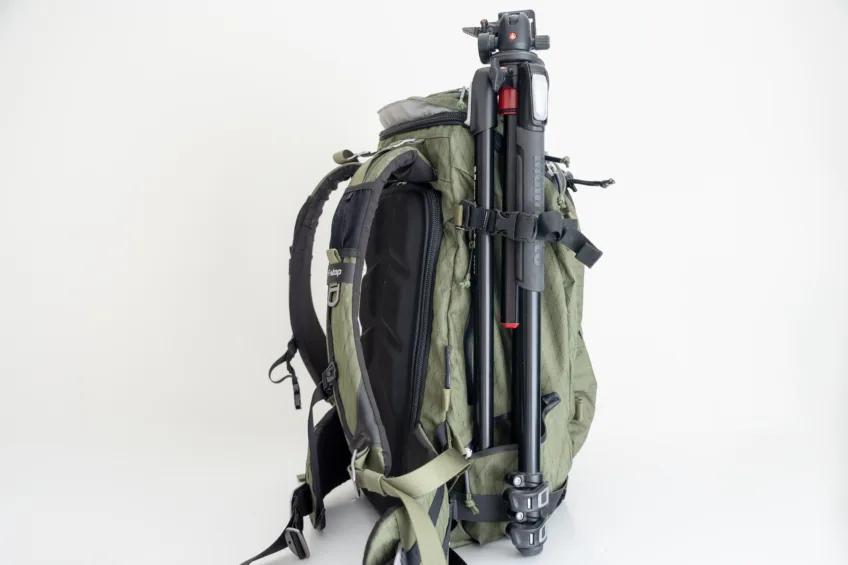
With the new Tilopa Duradiamond, the two side pockets have been split into two: one vertical and another horizontal. This makes them much more versatile, carrying smaller items in the horizontal while and the vertical pocket is still big enough for our water bottle. The horizontal pocket also doubles up as a holding pouch for tripod feet when strapped to the side, this leaves the vertical pocket free for other uses. All in all, fantastic changes.
From good to bad. A major downside to the new Tilopa is the removal of the side and front straps (F-Stop Gear call these gatekeepers) which you now need to buy as extras if you need them. These are necessary if you want to carry a tripod with the bag as there are no straps to cinch one down by default.

The removal of default gatekeepers makes the bag cleaner; we never used the ones that run across the front so it’s nice not having these constantly scratching the floor or potentially getting caught on anything. But we feel they should have at least bundled a couple of free gatekeepers so that you can carry a tripod—it is a bag built for adventure and travel photographers and the substantial price of the bag itself. Note, they do offer bundles which all include a set of gatekeepers but again it would be nice to have these included with the bag only.
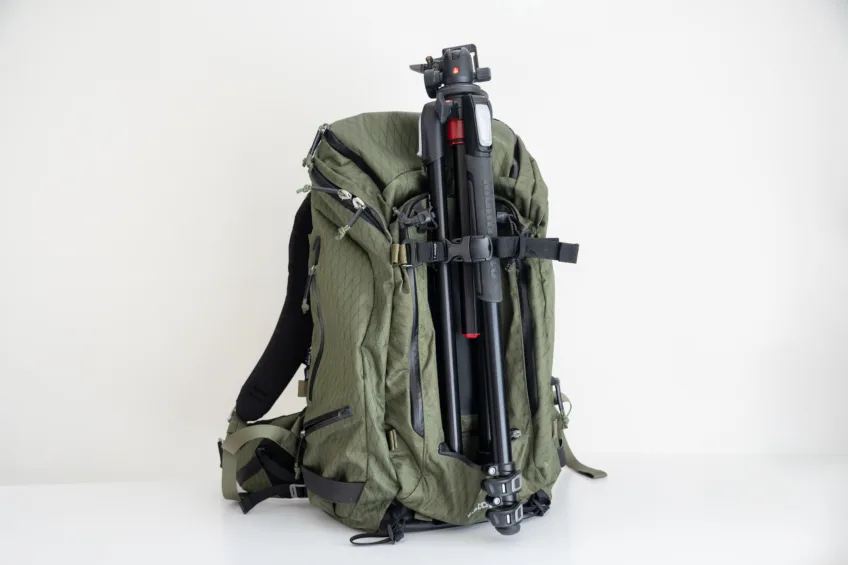

Moving to the front pocket, the foam layer on the outer flap has been removed which means your items inside are less protected but in the grand scheme it’s not a big deal as you wouldn’t put anything valuable or easily breakable in this pocket because it’s the part of the bag that strikes the ground first. We like the removal of the padding as it gives us more space to shove items such as raincoats, rain covers, down jackets and other items we want to grab quickly. The other change to the front pocket is the inclusion of a zipper mesh compartment—great for organization.

Last, but not least, of the changes on the exterior is the reinforced back handle. We use this handle all the time as it’s the most convenient way to pick the bag up. With the old Tilopa, if your bag was heavy and full of gear then that thin handle would dig into your hands and hurt to carry. The new thicker, padded handle is a joy to use, distributing the weight nicely across the palm of your hand and offering more material to grip on.
If you’ve used the old Tilopa then you’ll be happy to know most of the awesome features remain, including the super durable TPU material on the bottom and front of the bag (areas that constantly touch the floor) as well as the big back panel for easy access to your camera gear.
Inside the Bag


F-Stop Gear invented the removable camera insert for camera bags which is now widely adopted in the market. Often you’ll see the term ICU (internal camera unit) used when talking about other company camera inserts but that name is exclusively for F-Stop Gear camera inserts. The Duradiamond Tilopa continues with the same ICU system so if you already own one of their ICUs you can just plug and play. And if you’re new to F-Stop they have bundles which include inserts that range from different sizes. We mainly use the Medium Slope ICU inside the Tilopa but also have a Medium Shallow and Small ICU. You can comfortably stack a medium and small ICU in the Tilopa if you need to carry extra gear.



One of the biggest problems we had with the old Tilopa was carrying a laptop. Previously, the only place you could “safely” squeeze one in was in the water bladder pouch but this is a pain to access if your bag is full as you need to dig out some items before you can grab it. The other problem was the bladder pouch was on the front wall of the bag which meant it struck the floor first—not ideal with a laptop.

The back panel had a simple zipper pouch and molle system which you could strap on different accessories and pouches. It seems like a great idea as you can select the pouches and attachments which fit your needs but unfortunately, there’s zero clearance when zipped up so it presses against your camera gear. We had some pouches attached and unfortunately the zippers and buckles on those started scratching our gear so we ultimately removed these.



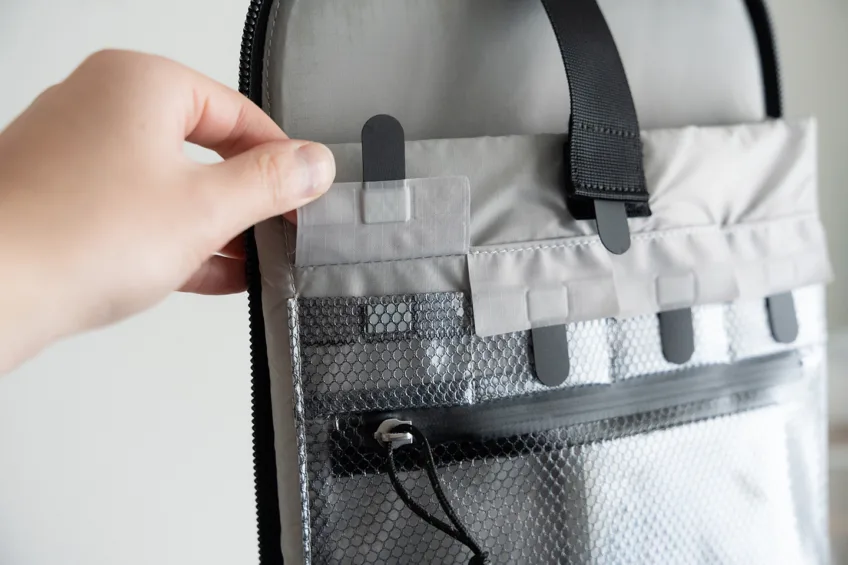
Flip open the new Tilopa’s back panel and you’ll find a completely redesigned panel organizer including a lovely cushioned laptop sleeve. The redesigned panel was the number one reason we wanted to upgrade to the new Tilopa as it makes our lives as travel photographers so much easier. The back panel features magnetic pouches and zip pockets for all those miscellaneous items; previously we would bung them into the ICU but would fall out and get lost in the bag somewhere, now they’re nicely stored in an easily accessible place.

Moving to the top panel, you’ll find a one-zipper split pocket over the previous mesh one—a nice upgrade if that’s where you put sunglasses or filters. What was disappointing was the decision to remove the key clip that was attached to the top internal panel. This used to be a lifesaver as it deterred theft and made it so we always knew where to look for our keys. When browsing the internet you might find a review or two of the Duradiamond which includes the key clip in the top compartment but we’ve had confirmation from F-Stop Gear that this has been removed “to make the pack lighter and to lower the waste creation.”
Verdict

The F-Stop Gear Tilopa Duradiamond took what was great about the previous generation bag and improved on it in almost every single way. It’s not going to be a bag for everyone; if you don’t travel as frequently, then you might want to consider their Ajna lineup which is smaller and more appropriate for everyday carry situations. But if you travel fairly frequently or for longer durations and you need extra space and don’t want to compromise on a good camera bag, we’ve yet to find one we love as much as the F-Stop Gear Tilopa Duradiamond.

 Hello, we’re Eric and Sarah – a couple of travel photographers and creatives from the UK.
Hello, we’re Eric and Sarah – a couple of travel photographers and creatives from the UK.

